The meandering topography of Puget Sound, my home since 2004, offers in winter a good number of shore dive sites sheltered from inclement weather. However, its relentless overcast sky can significantly increase a craving for sunlight. Last December my buddy had a whole week off work for Christmas and we decided to escape the gloomy Pacific Northwest by driving to sunny Monterey and diving in California waters for the first time.
One great advantage to dive in Monterey for scuba divers on a shoe string like us was that the city had a campground close to all the amenities, dive shops and very convenient dive sites. The air was so arid that at night we could leave our suits outside and pick them up the following morning completely dry, a rare occurrence here in the Pacific Northwest. The campground was located in the Veteran’s Memorial Park in a quiet wooded neighborhood home to a variety of creatures including raccoons. I was pleased to discover that they did not have a taste for scuba gear. Although the sites did not have hookups for electricity, there were hot showers and we were able to find a spot without reservation, rinse our gear and charge batteries.
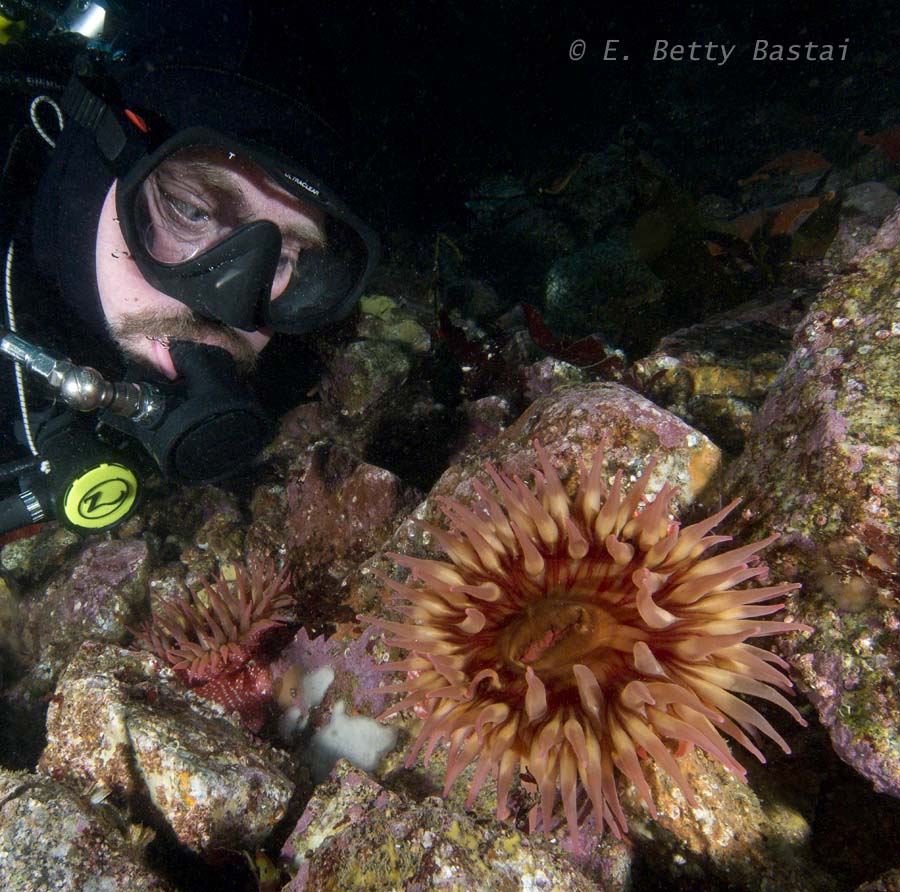
During our four days in Monterey, a cheering sun evaporated our Pacific Northwest winter blues and we were happy to find steel tanks available for rent (like the ones we left at home because of the long drive) at Bamboo Reef Diving Center. After talking to the friendly staff, who helped us choose the most suitable dive sites for our skill level, we started our Monterey underwater tour by diving the easily accessible “breakwater” or Coast Guard Pier, just a few blocks from the dive shop and Cannery Row.
The swells at the pier seemed manageable. We had experienced rough surge few times in Mexico and back home so we were not totally new to the feeling of being tossed around by wave action. We negotiated the sea breakers without problems. Not surprisingly, the visibility was very poor in shallow water but at 20 feet and below opened up to 30 feet. I immediately noticed that the water was not as green as in Puget Sound; seeing a higher level of blue was a welcoming change. The water was also warmer than expected: 54 rather than 48 °F. It was like summer in Puget Sound! After being submerged for one hour my neoprene-wrapped fingers were not freezing cold.
At a depth of 37 feet a cacophony of red, yellow, orange, pink, purple and blue surrounded us. Innumerable unfamiliar variably patterned and colored bat stars were crawling on rocks and boulders; at a close inspection some of those rocks were covered with strawberry anemones and yellow-orange zoanthids while large fish-eating anemones and gracefully decorated white-spotted anemones were showing off their different hues of red. Nudibranchs such as sea lemons, clown and white giant dorids were busy feeding on sponges and laying eggs. Then unknown fishes began to approach us: black perch, a pale yellow-green rockfish with a dark spot on the gill cover that reminded me of a brown (it was a kelp rockfish), a large differently shaped fish with beautiful blue eyes swam by hastily (an opaleye) and a lot of young-of-the-year rockfishes emerged from crevices.
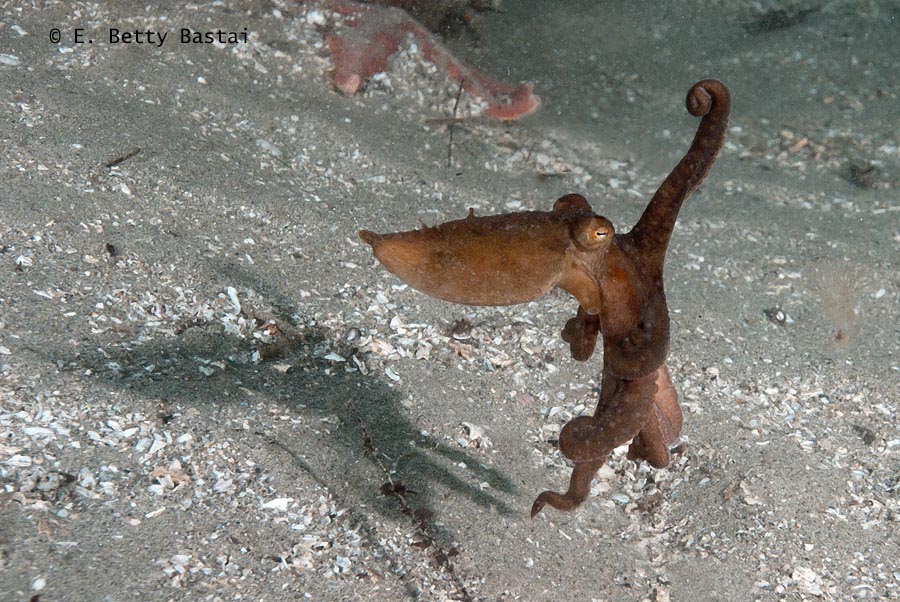
At one point my buddy signaled to me to look at the sandy bottom: a red octopus was exploring its surroundings with its extended arms. Excited, I messed with the camera to get the settings right and lost track of what was going on around me. Several minutes went by and, suddenly, my buddy grabbed my shoulder and shook it forcefully. I looked up and froze: a harbor seal had stealthily and swiftly shown up out of the nowhere and was hanging around to check us out; it was few feet away from me.
I have had brief encounters scuba diving with harbor seals in Puget Sound before, but I was never the center of the attention. This Californian seal had a different attitude from its northern cousins. After quickly searching for food under rocks, it turned around, looked into my eyes and dashed toward me. Frantically, I tried to change the camera settings thinking that I could not miss this extraordinary photographic opportunity but after wasting precious seconds I yelled inside my head: “To hell with the settings, I need to shoot now!” The seal stayed with us for a good amount of time for pinniped standards but still it was swimming all over the place as if its flippers were on fire. I pressed the release button several times without seeing what was displayed on the camera LCD screen hoping for the best.
What I did not know was that the seal would give me another chance later. During our second scuba dive it visited us again but this time the animal was all over me. Shamelessly, a burning curiosity pushed the marine mammal to “embrace” me while checking the top of my hooded head. My nose almost touched the animals’ belly. I stood still “bubbless”. The only thing I could see was the animal’s spotted skin. I did not have any room to maneuver and move the camera so taking pictures was impossible. I was totally taken by surprise by its unexpected behavior but I did not feel threatened; on the contrary, I must say that the temptation to pet that plump belly was very strong.
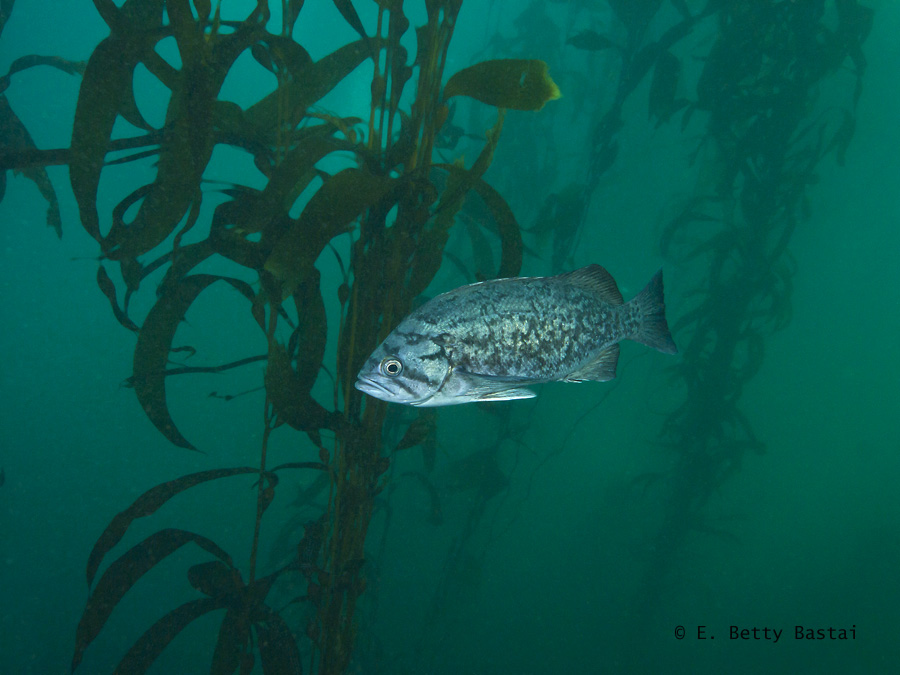
After two days of remarkable scuba diving at the Monterey breakwater we took our chances and luckily were able to dive at Point Lobos State Reserve. The parking lot at Whaler’s Cove was buzzing with divers and hikers. After checking the site we chose to explore the middle reef which required the least amount of surface swimming. The swells did not seem particularly powerful but soon I discovered how deceptive my first impression was. We entered the water at a boat ramp crammed between rocks. As the day progressed, we realized that entering was easier than exiting.
Not knowing how bad the surge was under the surface we wanted to conserve extra air in case we had to work harder than usual. In the end, we never reached our planned depth of 60 ft. because after assessing the waves’ strength we changed our dive profile and hung around in the 40 ft. range instead. The visibility at 20 feet was pretty bad. The wave action was scattering sand and organic debris in all directions. Once we swam into deeper water it got better reaching 15/20 feet. After planting myself on the bottom I looked up hoping to have a glimpse of the giant kelp forest as I had seen in photographs published by scuba diving magazines. The sunbeams filtering through the kelp that had survived the uprooting action of winter swells was not a sight as glamorous as those pictures but still it evoked a sense of marveling luminous verticality reminiscent of a Pacific Northwest rainforest on a sunny day.
During our first dive the ghostly shadow of a pinniped showed up for an instant in the cloudy water over rocks decorated with pink coralline algae. I turned to the opposite direction and had a brief encounter with a chubby looking fish with rectangular white markings on its body (a kelp bass); I also managed to see a rockfish that I could easily have confused with a copper if it was not for the fish’s stoic stillness. After taking a good look at it I was able to determine that it was not a copper rockfish but something more exotic: a gopher.
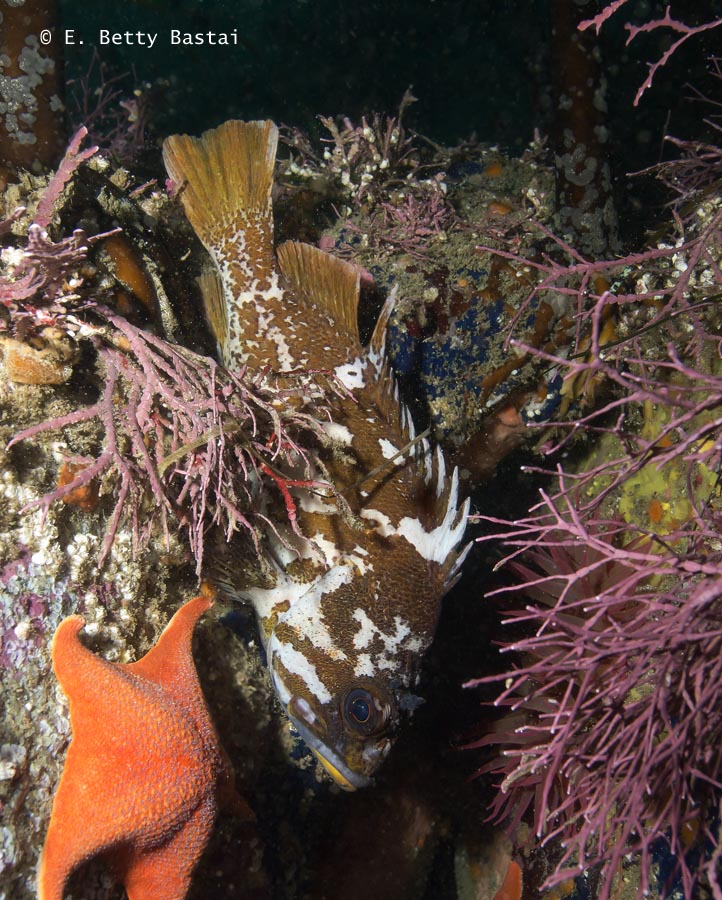
At 40 feet we were swinging along with the rhythm of waves that were rocking us back and forth like the kelp rockfish that was hiding in the kelp. Then I spotted the prettiest cabezon that I have ever seen. It was heavily blotched with pink, just like its surroundings. On the way back to the boat ramp I noticed that a school of fish was hanging around above our heads so I signaled my buddy to swim slowly to them. Away from the churning bottom and in the water column we discovered that there was an unexpected calm. We were able to hover with a bunch of blue rockfish (a species that so far we have never seen in the Pacific Northwest) for a while and have a good peaceful time observing their inquisitive behavior.
On the second scuba dive we surface swam further out the middle reef. At the end of the dive we misjudged the distance to the boat ramp, surfaced and realized how far it was still. So we figured that submerging again and swimming under few feet of water would have been easier than kicking on the surface. It turned out to be a mistake. The combination of zero visibility and what seemed to be a stronger wave action made me feel seasick. We re-surfaced, surface-swam and reached the point of entry without any other problems. However, the low tide had exposed the entire boat ramp and the breakers were crashing against our clumsy bodies more forcefully than before, so in order to get out of the water we felt that it would have been safer to crawl out rather stand up on our feet and walk on slippery rocks and concrete.
We spent our last day in Monterey diving at the breakwater. Sea lions were taking a nap on rocks that were not too far from the point of entry. We surface swam further out than before to take some pictures then submerged and kept an average depth at the 20-foot range. This time we scrutinized the rocks more thoroughly. A juvenile wolf eel timidly poked its head out of a crevice. Later, I miraculously spotted a rockfish that is rare in Washington waters: the Boccaccio. I had another look at a large black blob that I had seen in earlier dives that I thought was a sponge and noticed that it had a hard shell, a hole on the top of its spherical body and a pair of tentacles: it was a keyhole limpet on steroids.
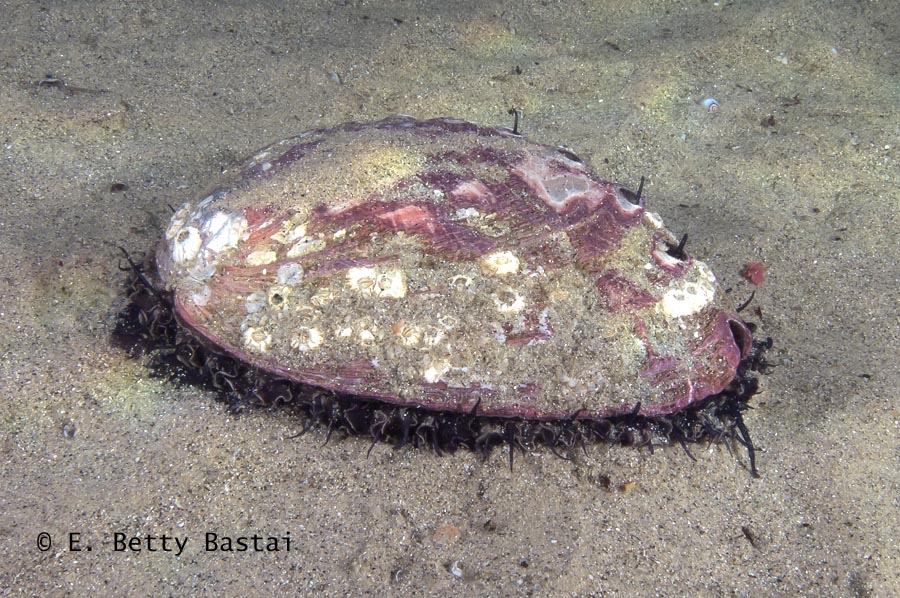
With my eyes so tuned up to scrutinize my environment at such close range I began to notice a marine invertebrate that is almost extinct in the state where I live: the abalone. They were holding onto rocks in narrow cracks so it was difficult to see what they really looked like. However, out of sheer luck, my buddy found one in four feet of water that was cruising at a steady speed on the sandy bottom revealing its beautiful shell in its full glory.
Diving in the breakwater was also filled with missed photographic opportunities. On the surface a sea otter was lazily floating belly up munching on some unfortunate invertebrate. The animal was too far away from me and my lens was too wide. While I was busy taking pictures of animals that kept popping out from nearby rocks a bird dived beside me barely missing my head. As soon as I turned to point the camera at it, the bird was already out of sight like an underwater shooting star. Finally, my buddy observed a couple of cormorants feverishly chasing fish while I was occupied with the camera.
The following morning, we packed our car to its loading limit and instead of following the slow, yet breathtakingly scenic coastal road as we did on the way down, we drove east to reach I5 and then north. On the road, as we watched the weather progressively deteriorating, our spirits remained invigorated by the Californian sun. Our minds were filled with terrific lasting memories of animal encounters and underwater southern dazzling beauty. There was no doubt that we would be back.
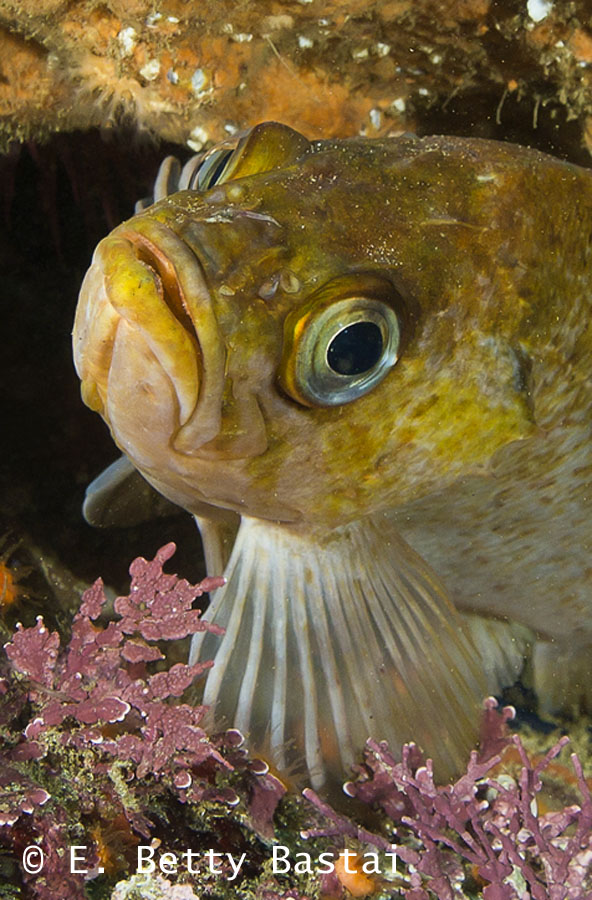
About the author:
Born in Italy, Elisabetta (Betty) Bastai learned to snorkel in the balmy and blue water of the Mediterranean Sea at a young age, but it was not until 2008 that she became a certified scuba diver in the cold and green water of Puget Sound, Washington. She is a visual artist and writer whose photographic work has been published by the national magazines Orion and The Sun and her scuba diving stories have appeared in Northwest Dive News. In 2012 two of her pictures of rockfishes were included in the book “A Guide to the Rockfishes, Thornyheads, and Scorpionfishes of the Northeast Pacific” published by the University of California Press. She received several awards including the GAP Grant from Artist Trust, Seattle, and the Patron Award from California State Polytechnic University, Pomona. During the summer of 2013 she filmed and edited an educational video about aquatic invasive species for the nonprofit Northern Forest Canoe Trail based in Vermont. The magazine Scuba & H20 Adventure recently published her article about the same subject.
You can view her work at: http://openwaterbubbles.blogspot.com
www.bettybastai.com
Her e-mail address is: bettybastai@gmail.com
